50 Acknowledging My Future
When you stop to think about all the people in your Personal Learning Networks (PLNs) who have helped you or made you what you are, it quickly turns into a telephone directory. These acknowledgements started small with a few thanks to students in section 0.10.1 but then it rapidly got out of control and ended up being a chapter in itself.
This guidebook would not have been possible without the direct, and indirect contributions of everyone listed here. Thanks to everyone in this chapter, part of my PLNs, see figure 50.1
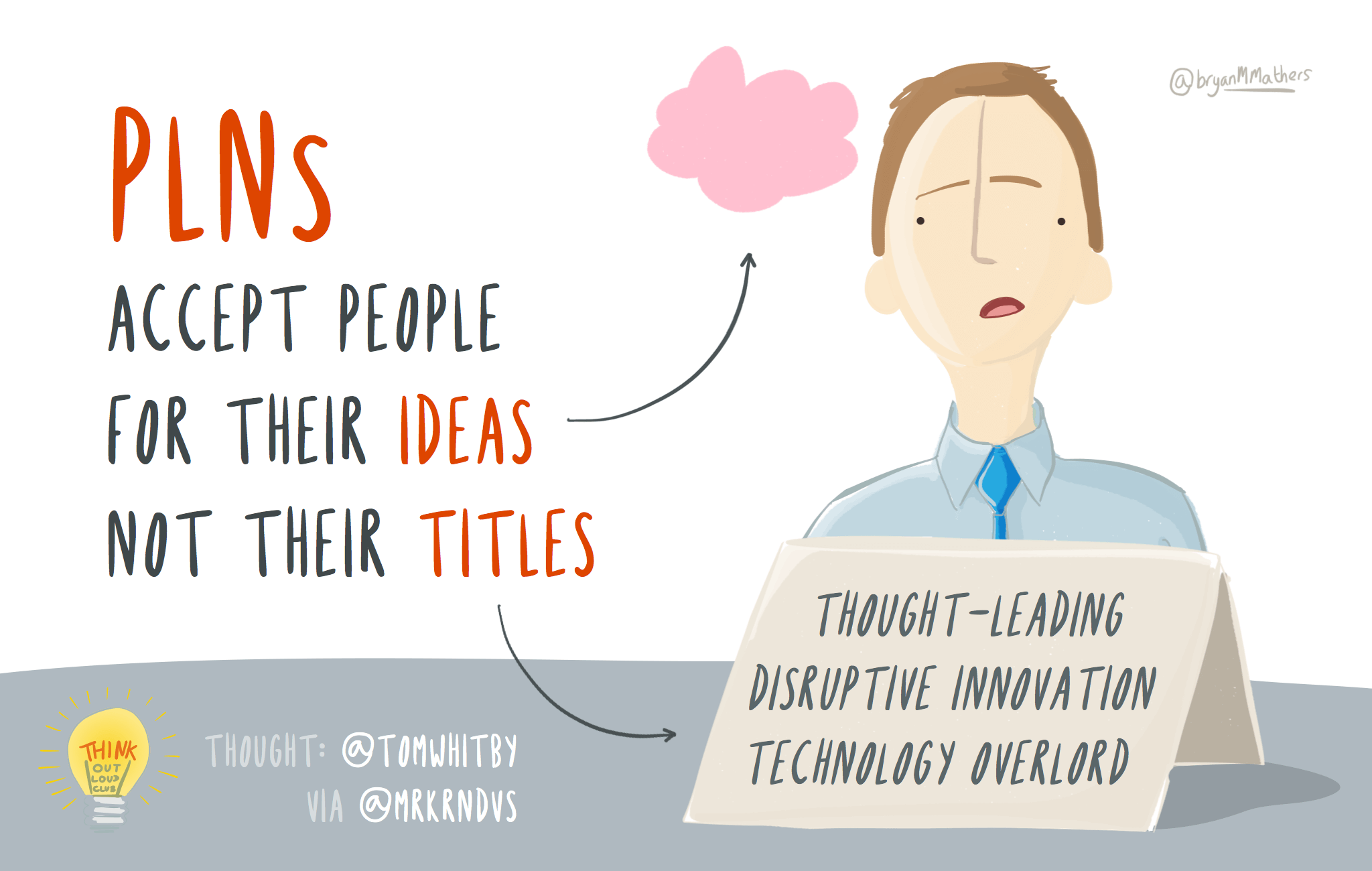
Figure 50.1: Some people who’ve helped me have very grand job titles like the THOUGHT-LEADING DISRUPTIVE INNOVATION TECHNOLOGY OVERLORD pictured here. Others do not. Eithery way, their titles are tinsel (Shelley 1812) but I’m grateful for what they taught me, whatever their title(s). This chapter acknowledges some of them. PLNS figure from a thought by tomwhitby.com via Aaron Davis by Visual Thinkery is licensed under CC-BY-ND
50.1 Thank you students
Thanks again to all the students who’ve contributed to this book, directly or indirectly described in section 0.10.1.
# Coding Comment
These acknowledgements are really looooooong because I try to practice what I preach about the importance of expressing gratitude, see section 3.4. It also serves as a live demonstration of a (public) gratitude journal. Expressing gratitude, publicly and privately, is a simple and proven technique for improving your mental health. It will also improve the mental health of the people who you thank, and strengthen the communities that you are part of, see 3.8.
50.2 Thank you employers
Thanks to all the organisations who have employed students from the Department of Computer Science as either summer interns, year long placements or graduates. A big chunk of this guidebook documents their experience of employers and their graduate recruitment programs.
Thanks to Niall Beard and Sharif Salah at Google for introducing me to Google’s Technical Writing course in section 4.6.2. Writing is rewriting!
So, thanks employers for employing our students. 🙏
50.3 Thank you colleagues
I’ve also had significant support from colleagues in the Department of Computer Science , and many other parts of the University: (engineering, natural sciences, social sciences, biology, medicine and health etc) and support staff at the University of Manchester: Careers service and Alumni office.
Thank you Carole Goble for building the community that supported me through postgraduate study. Thanks for creating the environment which this book was written in, especially the e-Science lab, Information Management Group (IMG), Software Sustainability Institute (software.ac.uk) and their spin-offs. Thanks for patiently re-teaching me how to write better by covering early drafts of my Masters thesis in red ink and less patiently (on subsequent revisions) swear words. 🤬
Thank you Steve Furber for playing guitar in our “boy band” Tuning Complete, see chapter 37. All we’ve got is your bass guitar, three chords and the truth. (Howard 1951; Dylan and Hewson 1988) 🎸
Thank you Jim Miles for encouraging me to write a book shortly after you offered me a job. I thought you were joking (about the book) but it actually turned out to be another one of your great ideas. Thanks Jim. 🙏
I’d also like to thank the only three people in the whole world who’ve had the misfortune pleasure of reading all of my PhD thesis cover to cover; Robert Stevens, Anil Wipat and Steve Pettifer. I suspect it was as painful for you to read as it was for me to write it. Thanks Robert for your relentless patience and giving me a well timed, well aimed kick up the (proverbial) arse to write this book in the Midland Hotel, Manchester at the May ball.
So, thank you colleagues for being collegiate. You make the University of Manchester an enjoyable place to work.
50.3.1 Thanks to academic staff
Thanks to past and present academic colleagues (see figure 50.2), PhD students and academic staff at the University of Manchester (and elsewhere) who have contributed to this guidebook and the environment it was written in. We are bound together by the power of weak ties (section 11.2.5) alongside stronger forces and friendships.
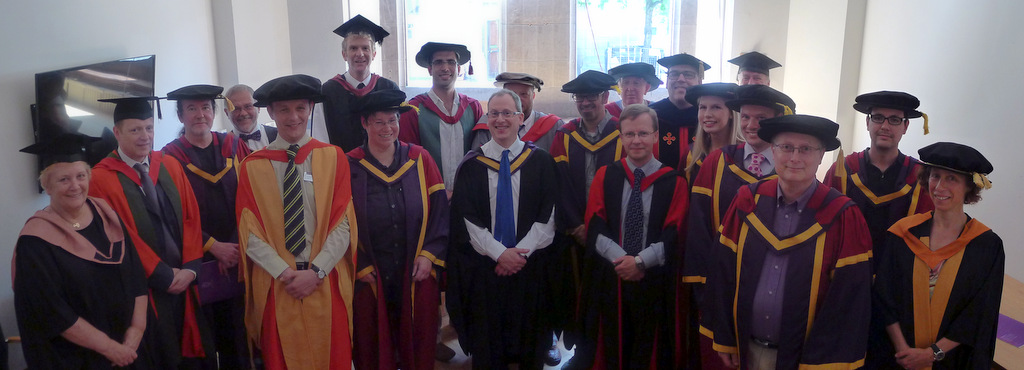
Figure 50.2: Wearing silly hats and even sillier frocks for a graduation ceremony in the Whitworth Building, Manchester in 2013. From left to right Alex Walker, Tim Morris, John Latham, Graham Gough, Yours Truly, Sean Bechhofer, Andrea Schalk, Gavin Brown, Toby Howard, Robert Stevens, Simon Harper, Barry Cheetham, Norman Paton, Bijan Parsia, Caroline Jay, Allan Ramsay, Darren Lunn, Nick Filer, Markel Vigo and Ulrike Sattler. Picture by Toby Howard. 🎓
They include (in alphabetical order): Muideen Ajagbe, Pinar Alper, Sophia Ananiadou, Mikel Egaña Aranguren, Constantinos Astreos, Terri Attwood, Sam Bail, Robin Baker, Richard Banach, Riza Batista-Navarro, Michael Bada, Niall Beard, Sean Bechhofer, Dick Benton, Casey Bergman, Hannah Berry, Lynne Bianchi, Ahmad Bilal, Rupert Blackstone, Stewart Blakeway, Petrut Bogdan, Caroline Bowsher, Linda Brackenbury, Andy Brass, Judy Brewer, Christian Brenninkmeijer, Andy Bridge, Andy Brown, James Brooks, Gavin Brown, Nick Brown, Mihai Bujanca, Bob Callow, Alex Casson, Lloyd Cawthorne, Zhongyan Chen, Oscar Corcho, Grant Campbell, Angelo Cangelosi, Peter Capon, Andy Carpenter, Nicola Carrier, Thomas Carroll, Sarah Cartmell, Barry Cheetham, Ke Chen, Sarah Clinch, Hannah Cobb, Mike Croucher, Laurence Cook, Ian Cottam, Brian Cox, Ang Davies, Carmel Dickinson, Simone Di Cola, Stavrina Dimosthenous, Dave De Roure, Paul Dobson, Clare Dixon, Janine Dixon, Danny Dresner, Nick Drummond, Ian Dunlop, Warwick Dunn, Dominic Duxbury, Doug Edwards, Sean R. Edwards, Iliada Eleftheriou, Anas Elhag, Suzanne Embury, Michael Emes, Roland Ennos, Harry Epton, Alvaro Fernandes, Jonathan Ferns, Michele Filannino, Nick Filer, Michael Fisher, Paul Fisher, R. W. Foster, Steve Furber, Andre Freitas, Aphrodite Galata, Matthew Gamble, Jim Garside, Kristian Garza, Freddie Gent, Chris Gilbert, Danielle George, Richard Giordano, Birte Glimm, Carole Goble, Antoon Goderis, Rafael Gonçalves, Roy Goodacre, Graham Gough, Anastasios Gounaris, Bernardo Cuenca Grau, Peter R. Green, Arlene Grenade, Keith Gull, John Gurd, Luke Hakes, Robert Haines, Guy Hanke, Lucy Harris, Angel Harper, Simon Harper, Alison Harvey, Jonathan Heathcote, Alex Henderson, Martin Henery, Gareth Henshall, Andrew Horn, Farid Kahn, Chris Hardacre, Matthew Horridge, Ian Horrocks, Toby Howard, Roger Hubbold, Luigi Iannone, Jane Ilsley, Jules Irenge, Duncan Ivison, Daniel Jameson, Olivia Jankiewicz, Caroline Jay, Mirantha Jayathilaka, Marianne Johnson, Huw Jones, Steven Jones, Simon Jupp, Yevgeny Kazakov, John Keane, Douglas Kell, Catriona Kennedy, Rachel Kenyon, Chris Knight, Joshua Knowles, Dirk Koch, Nikolaos Konstantinou, Christos Kotselidis, Ioannis Kotsiopoulos, Oliver Kutz, Alice Larkin, Peter Lammich, John Latham, Kung-Kiu Lau, Hugo Lefeuvre, Dave Lester, Peter Li, Zewen Liu, Phil Lord, Mikel Luján and Darren Lunn… (continued after the gratuitous picture break of figure 50.3)
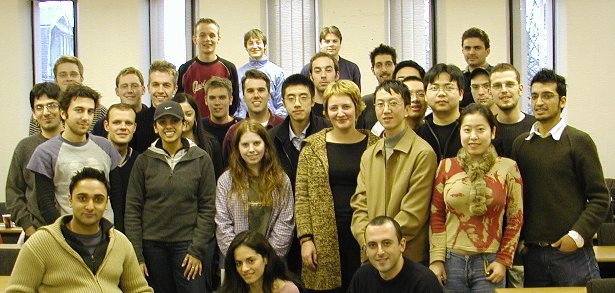
Figure 50.3: Masters of Science and former students of the MSc Computer Science class of 2003. This is a bit like Where’s Wally: can you find me in the photo? Unlike Wally I’m not wearing a red and white stripy jumper. Picture by Richard Giordano.
… (continued) Matthew Makin, Nicolas Matentzoglu, Paul Mativenga, Erica McAlister, Mary McGee Wood, Jennifer McBride, April McMahon, Merc and members of the Manchester University Mountaineering Club (MUMC), Simon Merrywest, Eleni Mikroyannidi, Zahra Montazeri, Colin Morris, Norman Morrison, Jane Mooney, Georgina Moulton, Boris Motik, Christoforos Moutafis, Tingting Mu, Ettore Murabito, Mustafa Mustafa, Javier Navaridas, Kostas Nikolou, Aleksandra Nenadic, Goran Nenadic, Paul Nutter, Steve McDermott, Jock McNaught, Mary McGee-Wood, Pedro Mendes, Sarah Mohammad-Qureshi, Tim Morris, Jennifer O’Brien, Tim O’Brien, Steve Oliver, Pierre Olivier, Mario Ramirez Orihuela, Stuart Owen, Ali Owrak, Liam Panchaud, Pavlos Petoumenos, David Petrescu, Luis Plana, Colin Puleston, Ignazio Palmisano, Dario Panada, Michael Parkin, Bijan Parsia, Jon Parkinson, Norman Paton, Jeff Pepper, Steve Pettifer, Ian Pratt-Hartmann, Mark Quinn, Rishi Ramgolam, Allan Ramsay, Magnus Rattray, Alasdair Rawsthorne, Farshid Rayhan, Alan Rector, Giles Reger, Graham Riley, David Robertson, Jeremy Rodgers, Clare Roebuck, Mauricio Jacobo Romero, Jenni Rose, Nancy Rothwell, William Rowe, Oliver Rhodes, David Rydeheard, Graham Riley, Daniella Ryding, Ulrike Sattler, Ahmed Saeed, Pejman Saeghe, Rizos Sakellariou, Pedro Sampaio, Sandra Sampaio, John Sargeant, Andrea Schalk, Viktor Schlegel, André van Schaik, Renate Schmidt, Baris Serhan, Jonathan Shapiro, Liz Sheffield, Lynn Sheppard, Bushra Sikander, Lemn Sissay, Vangelis Simeonidis, Kieran Smallbone, Alastair Smith, Stian Soiland-Reyes, Nikesh Solanki, Irena Spasic, David Spendlove, Laurence Stamford, Robert Stevens, Alan Stokes, Shoaib Sufi, Andrew Stewart, James Sumner, Neil Swainston, John H. Tallis, Paul Taplin, Federico Tavella, Chris Taylor, Tom Thomson, Dave Thorne, David Toluhi, Tony Trinci, Dimitri Tsarkov, Daniele Turi, Fiona Velez-Colby, Jake Vasilakes, Laura Vasques, Delia Vazquez, Giles Velarde, Chiara Del Vescovo, Markel Vigo, Sam de Visser, Andrei Voronkov, Niels Walet, Alex Walker, Louise Walker, Simon Watson, Nicholas Weise, Dieter Wiechart, Judy Williams, Igor Wodiany, Katy Wolstencroft, Natalie Wood, Chris Wroe, Crystal Wu, Lisheng Wu, Terry Wyatt, Yifan Xu, Viktor Yarmolenko, Yeliz Yesilada, He Yu, Serafeim Zanikolas, Xiao-Jun Zeng, Jun Zhao, Liping Zhao, Ning Zhang and Evgeny Zolin.
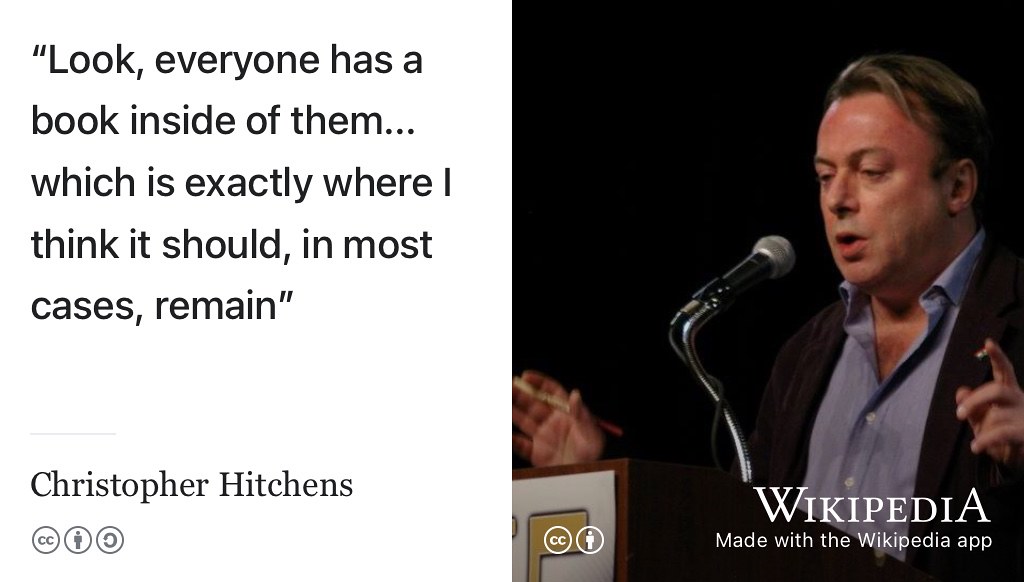
Figure 50.4: Optimists will tell you that “everyone has a book in them…”, but pessimists like Christopher Hitchens will add that “…in most cases that’s exactly where it should remain”. (Hitchens 1997) Despite Hitchens amusing trademark scepticism, I am optimistic about the power of natural languages, written and spoken. CC BY portrait of Christopher Hitchens by ensceptico via Wikimedia Commons w.wiki/3YK7 adapted using the Wikipedia app
So thanks academics for being even more sceptical than Christopher Hitchens, see figure 50.4. Thanks academics for being academic. 🙏
50.3.2 Thank you professional services staff
Thanks also to the superb support staff (past and present) from professional services, especially the Academic Support Office (ACSO), Student Support Office (SSO) and external affairs office in the Kilburn building. Professional services staff continue to make all the magic of teaching and learning possible: Alyx Adams, Daniele Atkinson, Cassie Barlow, Jasmine Barrow, Jennie Ball-Foster, Callam Barnes, Rosie Beaty, Nicholas Bell, Emma Bentley, Victoria Bezer, Jennie Blake, Christine Bowers, Ian Bradley, Daniel Bulman, Karen Butterworth, Miriam Cadney, Chris Calland, Stacey Casey, Ben Carter, Patricia Clift Martin, Chris Connolly, Freya Corrywright, Hannah Cousins, Amanda Conway, Emily Conway, Ellie Crompton, Esme Davies, Jean Davison, Lorna Dawson, Holly Dewsnip-Lloyd, Gavin Donald, Kathryn Downey, Lindsay Dunn, Nicola Evans, Molly Fletcher, Matthew Foulkes, Tammy Goldfeld, Penney Gordon-Lanes, Amelia Graham, Arlene Grenade, Jennifer Hallam, Charlotte Hart, Iain Hart, Ben Herbert, Thomas Hesford, Kay Hodgson, Kath Hopkins, Sarah Howard, Lynn Howarth, Yvonne Hung, Susie Hymas, Radina Ivanova, Dan Jagger, Alex Jones, Jeremy Jones, Sheezah Kausar, Jessicca Kateryniuk-Smith, Mike Keeley, Kamilla Kopec-Harding, Stephanie Lee, Dominic Laing, Gill Lester, Jez Lloyd, Ruth Maddocks, Cameron Macdonald, Kelly-Ann Mallon, Olie Marsh, Lisa Maycroft, Lisa McDonagh, Tony McDonald, Karon Mee, Anne Milligan, Sarah Millington, Rachel Mutters, Matthew Oakley, Alyson Owens, Chris Page, Carly Peesapati, Melanie Price, Abby Ragazzon-Smith, Chris Rhodes, Stephen Rhodes, Graham Richardson, Martin Ross, Beth Rotherham, Emily Sagues, Emma Sanders, Julian Skyrme, Elaine Sheehan, Angela Standish, Martine Storey, Kory Stout, Bernard Strutt, Hannah Thomas, Jannine Thomas, Joseph Tirone, Daisy Towers, Karen Varty, Anna Warburton-Ball, Richard Ward, Sarah White, Elizabeth Wilkinson, Andrew Whitmore, Rachael Willis, Sorrel Wilson, Lisa Wright, Mabel Yau, Juanjuan Zhang and Liyuan Zhong.
And Wendy. We all miss you and love you Wendy. #JusticeForWendy ✊🏽 Fight the Power! ✊🏽 (Ridenhour et al. 1989)
So, thanks professional services staff for being professional and supporting the work of academics doing research and teaching. 🙏
50.4 Thanks to funders
Thanks to support, financial and otherwise, at various stages from the following funding bodies:
- the Council of Professors and Heads of Computing (CPHC)
- the European Union (EU) and European Molecular Biology Laboratory (EMBL)
- the National Science Foundation (NSF)
- The Student Loans Company for financing my undergraduate degree
-
UK Research and Innovation (UKRI) and its consitutent parts:
- the Biotechnology and Biological Sciences Research Council (BBSRC)
- the Engineering and Physical Sciences Research Council (EPSRC)
- the Natural Environment Research Council (NERC)
- The Wikimedia Foundation, Wikimedia UK and the Royal Society.
- Wiltshire County Council for my undergraduate maintenance grant
Money makes the world go round and has enabled me to teach, learn and do research. So thanks funders for opening your purse strings. 🙏
50.5 Thank you SIGCSE
Thanks to the sigcse.org, the Special Interest Group (SIG) on Computer Science Education (CSE), part of the Association for Computing Machinery (acm.org). Thanks to my fellow uki-sigcse.acm.org board members Steven Bradley, Janet Carter, Tom Crick, Quintin Cutts, Rosanne English, Sally Fincher, Samia Kamal, Joseph McGuire and Sally Smith for your help, support and advice, see figure 50.5
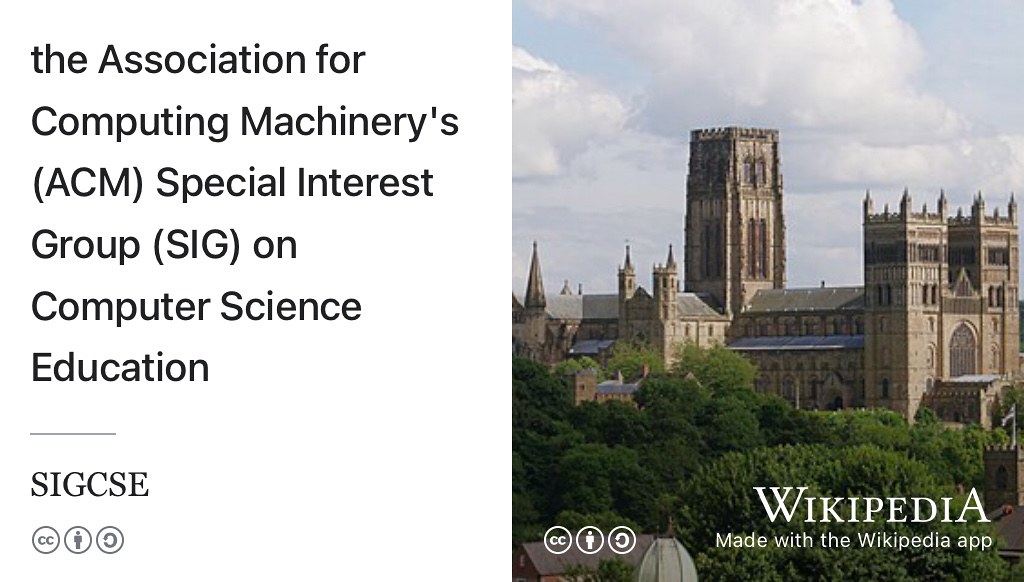
Figure 50.5: Every year in January practitioners and researchers in computing education, both within Computer Science departments and elsewhere gather for Computing Education Practice (CEP) in Durham. (Akrida and Zarb 2023) Come and join our vibrant and thriving community! Picture of Durham Cathedral by Mattbuck via Wikimedia Commons w.wiki/4acc adapted using the Wikipedia app
Thanks to all the SIGCSE journal clubbers including Brett Becker, Neil Brown, Ceredig Cattanach-Chell, Katie Cunningham, James Davenport, Rodrigo Ferreira, Colin Johnson, Michael Kölling, Nicola Looker, Julia Markel, Jim Paterson, James Prather, Sue Sentance, David Sutton, Moshe Vardi, Jane Waite, Pierre Weill-Tessier and Michel Wermelinger. Many of our journal club conversations have fed directly into the content of this guidebook.
Thanks to Sally Fincher and Janet Finlay whose report Computing Graduate Employability: Sharing Practice (Fincher and Finlay 2016) has had a big influence on this guidebook.
So thanks SIGCSE for being special and interesting. 🙏
50.5.1 Thank you scientists
There is a wider community of scientists, engineers and scholars that have influenced this guidebook:
- Thanks to David Malan (@malan) for CS50 which is full of good ideas. (Malan 2010, 2020, 2021) Thanks to Cristian Bodnar for inviting David to run CS50 in Manchester in 2017 which was a great introduction to David’s work (Malan 2017)
- Thanks to Santiago Perez De Rosso for some great examples of badly written documentation in section 4.5.1. (Rosso and Jackson 2016; Rosso 2017)
- Thanks to Laurie Santos, for The Science of Well-being (TSOWB) (Santos 2022b) which was been a big influence on this book had a gradual but significant effect on my personal and professional life. I’ve tried to distill some of the ideas into chapter 3 on Nurturing your future
- Thanks to Hadley Wickham (@hadley), Mine Çetinkaya-Rundel (@mine-cetinkaya-rundel) and Garrett Grolemund (@garrettgman) for R for Data Science (Wickham and Grolemund 2017; Wickham, Çetinkaya-Rundel, and Grolemund 2023) which helped me get started (and keep going) with R and its associated of markdowns. If you’re reading this page in some kind of web browser, the stylesheet used here is re-used from the first edition of the book r4ds.had.co.nz
- Thanks to David Walker for his book Energy, Plants & Man which inspired the conversations and pictures idea behind this book. (D. Walker and Walker 1992)
- Thanks to Dave Cliff for your entertaining guest lectures for COMP101, see also figure 3.6
So thanks scientists (and engineers) for being scientific and engineering. 🙏
50.6 Thank you Bath
Thanks to the University of Bath for your excellent Postgraduate Certificate in Education (PGCE) course. I graduated with a PGCE in Science in 2011 and have been heavily influenced by the fantastic work of the schools in Swindon (section 50.8), Shaftesbury (section 50.7) and Stockport (section 50.9) where I worked. I also learnt heaps from fellow students on the course and its course leaders:
- Caroline Padley, Physics
- Steve Cooper, Chemistry
- Malcolm Ingram, Biology
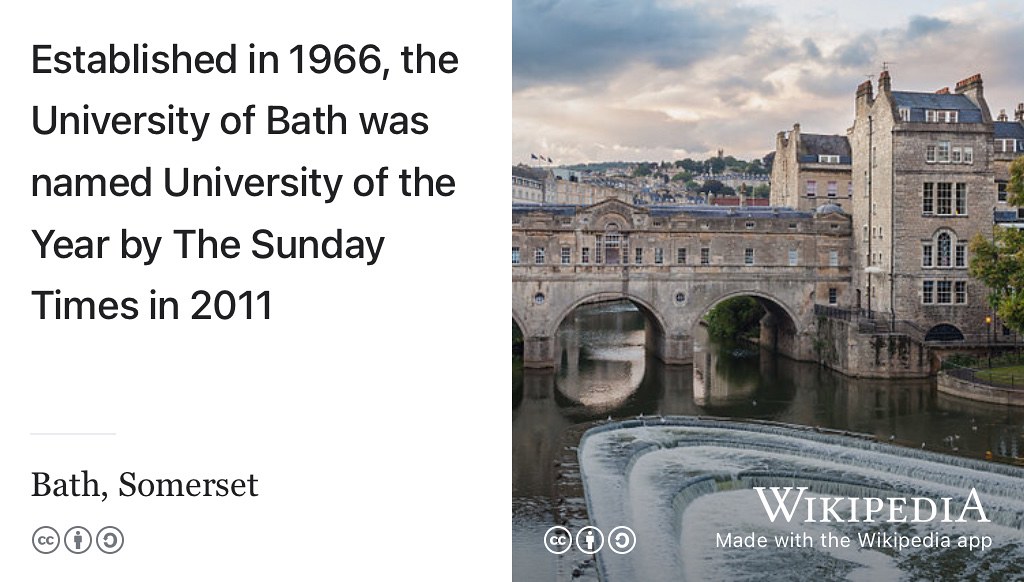
Figure 50.6: Named after its Roman Baths, the City of Bath in Somerset is home to the University of Bath which was named Sunday Times University of the Year in 2011. Picture of Pulteney Bridge by Diego Delso, delso.photo, License CC-BY-SA via Wikimedia Commons at w.wiki/3VWY adapted using the Wikipedia app
So thanks Bath for the initial teacher training (ITT), TeamBath™, the medicinal Aquae Sulis and the beautiful Cotswolds Area of Outstanding Natural Beauty (AONB). 🙏
50.7 Thank you Shaftesbury
Thanks to Chris Almond, David Ball, David Booth, Caroline Dallimore, Stuart Ferguson, Caroline Moss, Mr Travers and all the other staff and students at Shaftesbury School who hosted my first PGCE teaching placement, see figure 50.7. Thanks also to my fellow Bath trainees Katharine Platt, Harriet Edwards, Vicky Dury and Joan Shaw for sharing your knowledge through peer learning and peer instruction. Thanks Joan for keeping me awake on the long and winding west country roads to and from deepest darkest Dorset. Thanks for sharing the heavy burden of driving too.
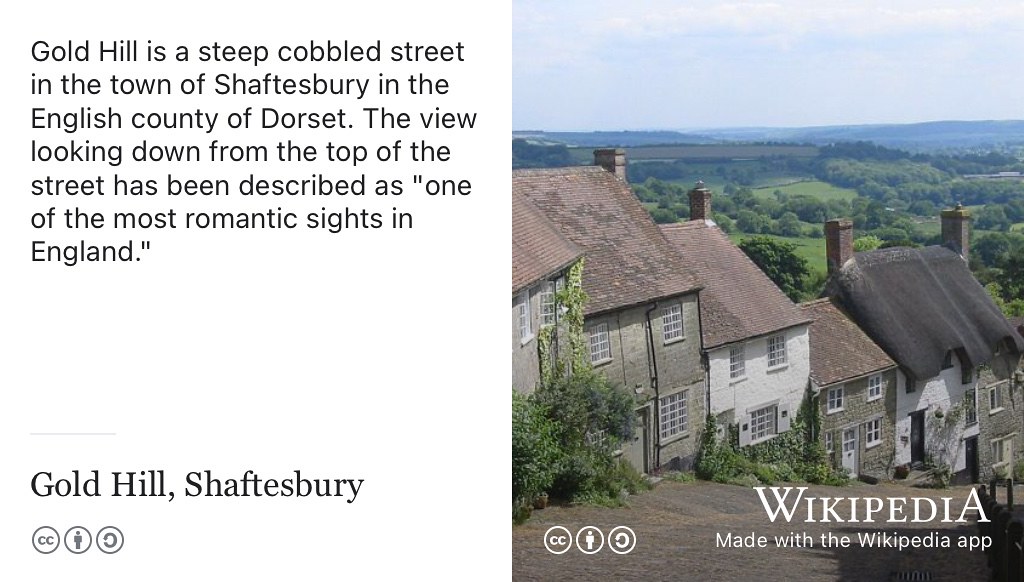
Figure 50.7: Shaftesbury in Dorset is the home of Gold Hill and Shaftesbury School. In the heart of Thomas Hardy’s Wessex, Shaftesbury has been used as a location for several films including a screen adaptation of Far from the Madding Crowd (Hardy 1874) and the Hovis advert, one of Britain’s best-loved adverts (Scott 1974). Image of Gold Hill by Sean Davis via Wikimedia Commons w.wiki/3LhD adapted using the Wikipedia app.
So thanks Shaftesbury for lessons on top of Gold Hill.
50.8 Thank you Swindon
Thanks to headteacher & physicist Clive Zimmerman, his team of staff, Mr M. Carter, Mr K. Thomas and the students of Greendown Community School (now Lydiard Park Academy) in Swindon, Wiltshire for hosting my second PGCE teaching placement. (Benke 2015) It was fun teaching you about electromagnetic waves using Alom Shaha’s jelly babies and kebab sticks shown in figure 50.8.
Figure 50.8: Alom Shaha demonstrates his awesome wave machine. Physics and jelly babies, what’s not to like? You can also watch the 4 minute video embedded in this figure at youtu.be/VE520z_ugcU (Shaha 2014)
So thanks Swindon for being great and western and Swindon Town Football Club, the best football team in the whole of the West Country. Proper job. 🙏
50.9 Thank you Stockport
Thanks to headteacher Joanne Meredith, her team of staff and the students at St. Annes Roman Catholic High School, Stockport for hosting my Newly Qualified Teacher (NQT) year. Thanks to Rebecca Dann, Michael Doody, Keith Doran and other members of the alternative (Elizabethan) “staff room” for your emotional, moral and practical support throughout a challenging year fuelled by poor mental health and midlife crisis. According to the Manchester Evening News, St. Anne’s is “the forgotten school” (H. Johnson 2020; Gill and Statham 2021), see figure 50.9, but I’ll never forget you or the lessons you taught me.

Figure 50.9: Good governance is crucial to good schools. Many forgotten schools like St. Anne’s R.C. High School, and the thousands of children in the UK they educate every year, need help from skilled people like you on their governing boards. Why not serve your local community as a “critical friend” on the governing board of a school? All ages are welcome, but especially younger governors, see where are all the young school governors? (Tickle 2015) Take a look at governorsforschools.org.uk. Fair use image via Wikimedia Commons w.wiki/3Swt adapted using the Wikipedia app
So thanks Stockport for being Stopfordian. Thanks for the magnificent Stockport Viaduct and for The Hatters: It’s all that matters, Stockport Hatters. 🙏
50.10 Thank you Schools
Thanks to all the schools who’ve hosted our undergraduate students as part of an ongoing partnership between the University of Manchester and local schools called Coding their Future, see figure 50.10:
- Mrs Rowland at The Blue Coat School
- Mrs Barrow at Fairfield High School for Girls, Droylsden
- Mr Sinnott at Trinity Church of England High School, Hulme
- Mr Clarke at University Technical College (UTC@MediaCityUK), Salford
- Mr Jalloh at Manchester Communication Academy, Harpurhey
- Mrs Wood at The Barlow Roman Catholic High School, Didsbury
- Alan J. Harrison at William Hulme’s Grammar School, Whalley Range
- Mr Rath and Mrs Preddy at Cheadle Hulme High School, Stockport
- Mrs Murray at Laurus Cheadle Hulme, Stockport
- Mr Pownall and Mr. Clarke at Knutsford Academy, Knutsford
- Steve Pearce at Altrincham Grammar School for Girls, Trafford
- Pauline Wilcox at Altrincham Grammar School for Boys, Trafford
- Mr Millington and Mr. Charlton at Manchester Grammar School (MGS), Fallowfield
- Mr Stenhouse at Stretford Grammar School, Trafford
Thanks to Mr Shaw for hosting our primary school codeclub.org. Thanks to Mr Ince and Drew Povey for showing me around Harrop Fold School (now The Lowry Academy) in Salford, host of the Educating Greater Manchester television series on Channel 4. (Sandwell 2020)
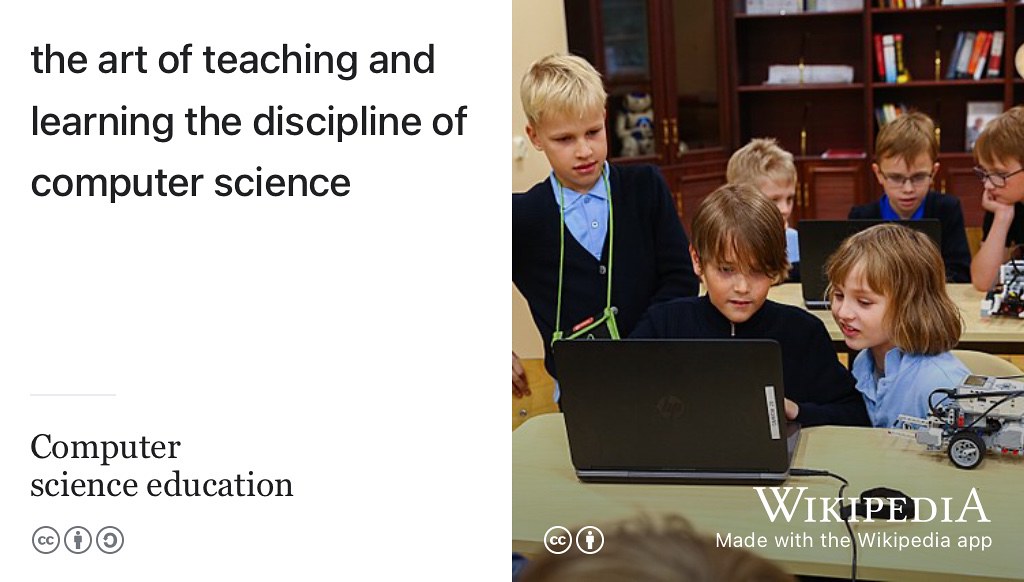
Figure 50.10: Is it art or is it science? It’s both. Thanks to all the schools in Greater Manchester who have supported the Coding their Future partnership allowing undergraduates to practice the art of computer science education in local secondary schools. Picture of children coding adapted from an original by Arno Mikkor on Wikimedia Commons w.wiki/65A2 using the Wikipedia app
Thanks to all the schools who interviewed me for my Newly Qualified Teacher (NQT) year. Doing interview lessons, meeting your students and your senior leadership teams was a gruelling but fascinating magical mystery tour of the UK education system, both public and private. These interviews were very productive failures:
-
Marie Getheridge at Writhlington School, Radstock, Somerset
- see their amazing Orchid project wsbeorchids.org run by Simon Pugh-Jones
- The Cooper School, Bicester, Oxfordshire
- Patrick Hazlewood at St John’s Marlborough, Wiltshire
- not to be confused its posher and famous next door neighbour Marlborough College
- Oasis Academy, Brislington, Bristol
- Redland Green School, Redland, Bristol
- The John of Gaunt School, Trowbridge, Wiltshire
- Rachael Warwick at Didcot Girls’ School, Didcot, Oxfordshire
-
Vicky Tuck at Cheltenham Ladies’ College, Cheltenham, Gloucestershire. (Ournalist 2010; Wilby 2011)
- This was the first time I’d ever set foot in a private school, managing to cross Michael Gove’s Berlin Wall of education by sneaking through Checkpoint Charlie un-challenged. It was an enlightening experience… (Gove 2014)
-
Blackburn College, Lancashire
- “I read the news today, oh boy! Four thousand holes in Blackburn, Lancashire” (Lennon and McCartney 1967)
So thanks schools, for all the excellent work you do educating people, whatever their background. 🙏
50.11 Thank you Oxford
Thanks to Martin Clutterbuck, Rebecca Clare, Richard O’Beirne, Simon Witter, Will Wilcox, Gavin, Howard, Isobel, Jess, Paddy, Sara, Spiro and everyone else in the journal production team at Blackwell Science Ltd for looking after me in my first job as a freshly minted graduate. Thanks to Nigel Blackwell, Bob Campbell and Jon Conibear without whom there wouldn’t have been any Blackwell for me to Science at. Thanks to Tim, Ruth and Sarah for all the nights in Oxford pubs. (Chelsom 2009)
Thanks to Eileen, Anne & Richard for giving me a home from home.
Thanks to John Chelsom, Kal Ahmed, Clare Ashton, Tim Cave, Mavis Cournane, Eddie Dillon, Niki Dinsey, Phil Gooch, Antony Grinyer, Debbie Hagger, Gareth Hudson, Steve Horwood, Chris Joyce, Joe McCann, Eddie Moore, Keith McCann, Dave Nurse, Ian Packard, Mark Pengelly, Al Power, Lillian Spearing, Ron Summers, Omar Tamer and the rest of the team at (and clients of) CSW Informatics Ltd (csw.co.uk) for looking after me in my second job after Uni and teaching me about Oxford Innovation.

Figure 50.11: Looking West over Oxford’s dreaming spires from South Park towards the city of Oxford. Picture adapted from an original by Tejvan Pettinger on Wikimedia Commons w.wiki/4Y25
Thanks to my fellow xmlsummerschool.com faculty: Bob du Charme, Paul Downey, Michael Kay, Jeni Tennison, Norman Walsh and Lauren Wood for the memories and the <markup/>. (R. Johnson 2004; Morali and Willis 1978)
X.S.L.T!
It's fun to program in... X.S.L.T!
Every line in your code
Is an XML node
And the program is one big treeThanks to Steven A. Hill, Jane Langdale and Chris Leaver at the University of Oxford (plants.ox.ac.uk) for interviewing me for a Gatsby Charitable Foundation DPhil scholarship. Thanks Chris for teaching me a painful but important lesson about the value of my education and grades. (Hull 2024)
So thanks Oxford for your dreaming spires, see figure 50.11. 🙏
50.12 Thank you Cambridge
Thanks to Christoph Steinbeck, Nico Adams, Marcus Ennis, Janna Hastings, Paula de Matos, Adriano Dekker, Kenneth Haug, Jo McEntyre, Pablo Moreno, Helen Parkinson, Mark Rijnbeek and Susanna-Assunta Sansone at the European Bioinformatics Institute (EBI, see figure 50.12) for looking after me during my time in Cambridge. Thanks to Rolf Apweiler, Michael Ashburner, Ewan Birney, Graham Cameron and Janet Thornton without whom there wouldn’t have been an EBI for me to work at. (Stroe 2019)
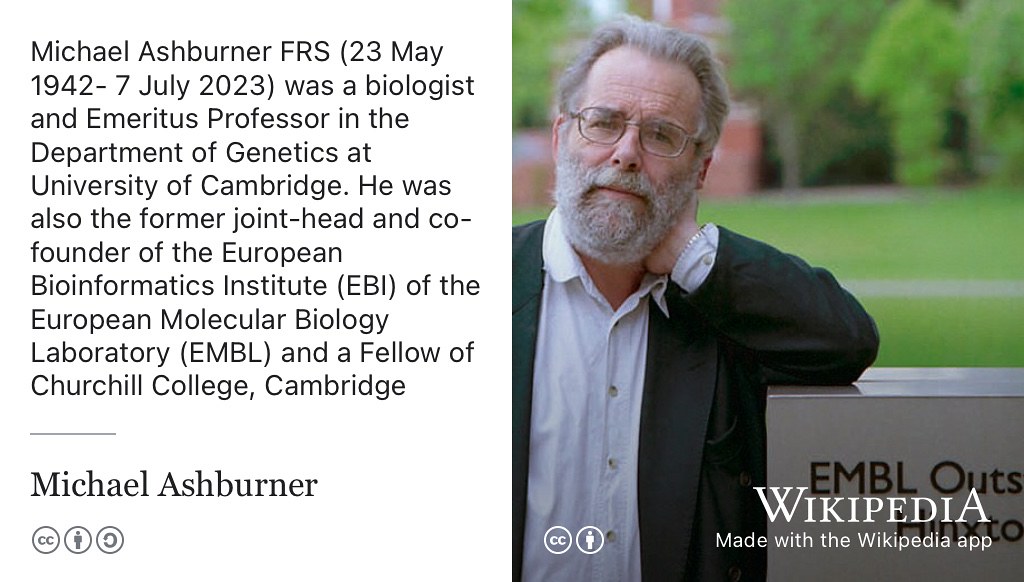
Figure 50.12: The European Bioinformatics Institute (EBI) is an outstation of the European Molecular Biology Laboratory (EMBL) which carries out research and provides services in bioinformatics from Hinxton, just outside Cambridge, UK. The EBI was co-founded by Michael Ashburner (1942–2023, pictured) and Graham Cameron. (Birney and Apweiler 2023; Stroe 2019) Portrait of Michael Ashburner by the Public Library of Science (PLOS) on Wikimedia Commons w.wiki/_vzkp using the Wikipedia app
So thanks Cambridge for Silicon Fen, I had a really fen-tastic time. I’ll get my coat. 🙏 (Whitehouse and Higson 1994)
50.13 Thank you Manchester
Thanks to Greater Mancunians beyond the University of Manchester: Anna, Mark Anderton, Andrea, Rob Aspin, Jon Atkinson, Charlie Ball, Paul Bason, Iain, Julian Bass, Amul Batra, Dean Belfield, Lisa Chan Brown, Martin Bryant, Gemma Cameron, Matthew Clark, Jeremy Coates, Craig, Darren Dancey, Craig Dean, Farhat Din, Anne Dornan, David Edmundson-Bird, Emily, Diana Erskine, Sherelle Fairweather, Shaun Fensom, Steven Flower, Tony Foggett, Katie Gallagher, Giles, Emma Grant, David Haikney, Damian Hughes, Mehran Jalaei, Daniel Jamieson, Matt Jarvis, Jamil Khalil, Ross Keeping, Val Kelly, Kitty, David Levine, Julie Lowndes, Tony McGrath, Chris Marsh, Amy Mather, Lisa Mather, Claire McDonald, Keith Miller, Geraint North, Alan O’Donohoe, Tomas Paulik, Damian Payton, Francesco Petrogalli, Paul, Peppi, Phil, Rich, Ros, Miles Rothbury, Paul Sherwood, Howard Simms, Adrian Slatcher, Jason Souloglou, Joe Sparrow, Martyn Spink, Katie Steckles, Matt Squire, Julian Tait, Rob Taylor, Rachel Thompson, Tom, Andrew Toolan, Hannah Tracey, Wesley Verne, Paul Vlissidis, Tony Walsh, Travis Walton, Ben Webb, Paul Wilshaw and Zoe for friendly Northern support and advice. Thanks to Andrew Back and Tim Harbour for wuthering my bytes at wutheringbytes.com.
Figure 50.13: I’m with Longfella (aka Tony Walsh) in believing that THIS is the place! You can watch the full 4 minute video embedded in this figure at youtu.be/PszMmYpQjPo (Longfella 2017) 🙏
So thank you for the music, the songs I’m singing. Thanks for all the joy they’re bringing. Thanks Manchester for the best football team in the world and being Mancunian, see figure 50.13. This is the place! (Longfella 2017)
50.14 Thank you Coventry
Thanks to Phil Harris, Steph Harris, Alan Gear, Jackie Gear, Ally, Neil, Esther, Francis Rayns, Graham Smith, Jeremy Cherfas, Morgen Cheshire, Margi Lennartsson Turner, Lady Godiva (see figure 50.14) and everyone else at the Henry Doubleday Research Association (HDRA) and Coventry University for hosting my industrial experience year during my undergraduate degree.
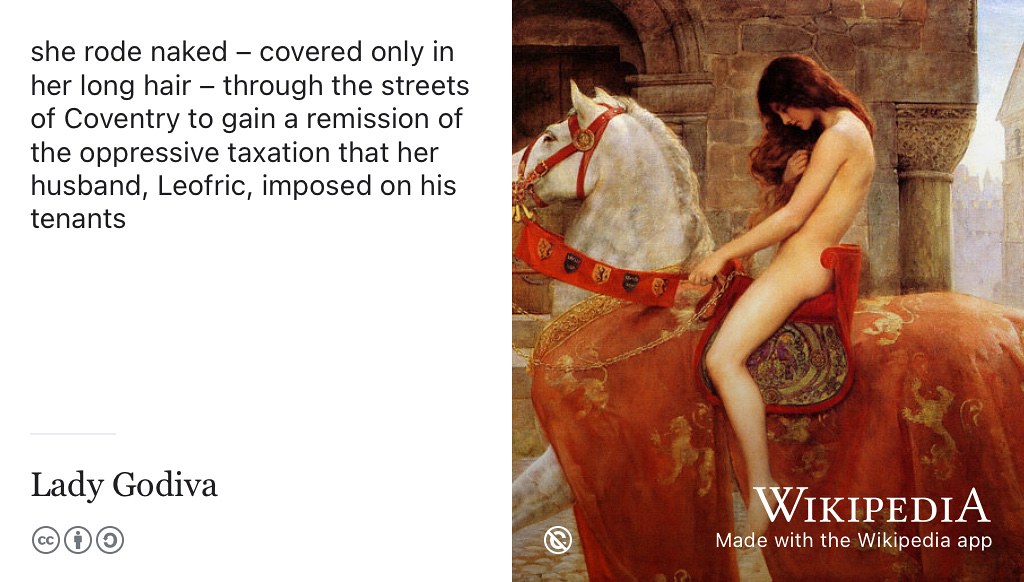
Figure 50.14: Covered only in her long hair, Lady Godiva rode naked through the streets of Coventry to protest about taxation. Sadly I was 900 years too late to miss the spectacle but there is a statue of her you can admire in Broadgate. Painting of Godiva by John Collier adapted from an original on Wikimedia Commons w.wiki/4aCU using the Wikipedia app
So thanks Coventry for naked women on horseback, a magnificent cathedral and the industrial experience. Thanks for being the place where I bumped into Bryan Mathers, see section 50.22. 🙏
50.15 Thank you Abisko
Thanks to Malcolm Press, Helena Björn van Praagh, Terry Callaghan, Jackie Potter, John Lee, Mats Sonesson, Nils-Åke Andersson, Rosie, Nick, Dylan, Karin, Kjell, Lennart, Marion, Martin, Ulf and everyone else at Abisko Scientific Research Station / Abisko Naturvetenskapliga Station (ANS, see figure 50.15) for hosting me as a summer research student investigating the effects climate change on subarctic heathlands. (Potter et al. 1995)33 Easily the best summer job I’ve ever had!
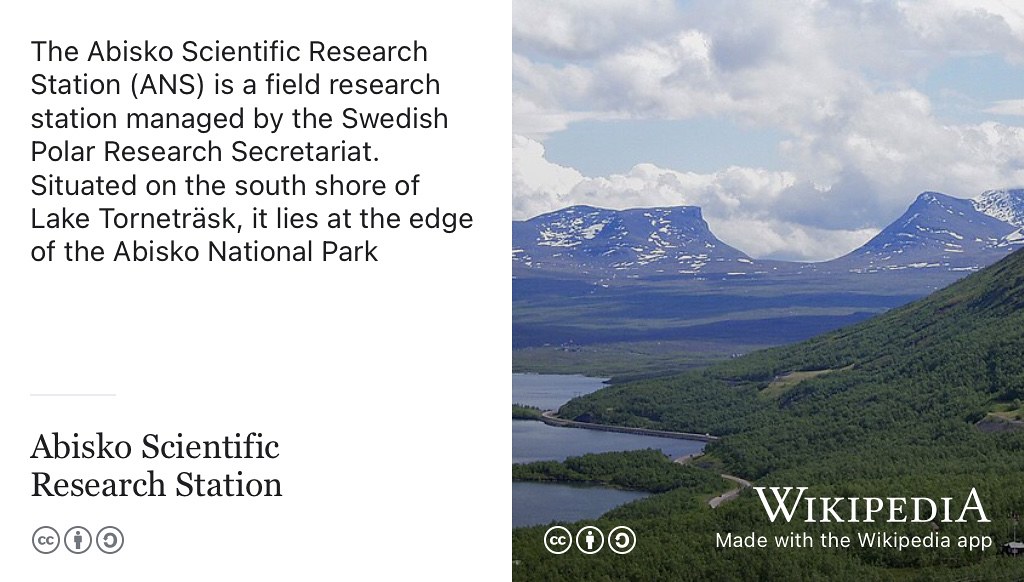
Figure 50.15: The Abisko Scientific Research Station (ANS) is a field research station in the Abisko National Park. The station hosts around 500 scientists each year from all over the world, who conduct research in subarctic environments. Picture of the view from Björkliden over the national park, past ANS on the shore of Lake Torneträsk towards the Gate to Lappland (Lapporten), by Lappländer on Wikimedia Commons w.wiki/4b3t adapted using the Wikipedia app 🇸🇪
So thanks (tack) Abisko for all the saunas, fika, midnight sun and Swedish hospitality. 🙏
50.16 Thank you America
Thanks to the British Universities North America Club (BUNAC) (see figure 50.16) for sponsoring my Exchange Visitor Student Visa which allowed me spend an awesome summer cooking breakfasts for guests at the Phillips Beach Plaza Hotel in Ocean City, Maryland. (Dubel 2021) If the way to a person’s heart is through their stomach. (Chef 2023) then I travelled to the heart of America through its big breakfasty stomach. Thanks to Andy B. for flagging it. 🇬🇧🇺🇸
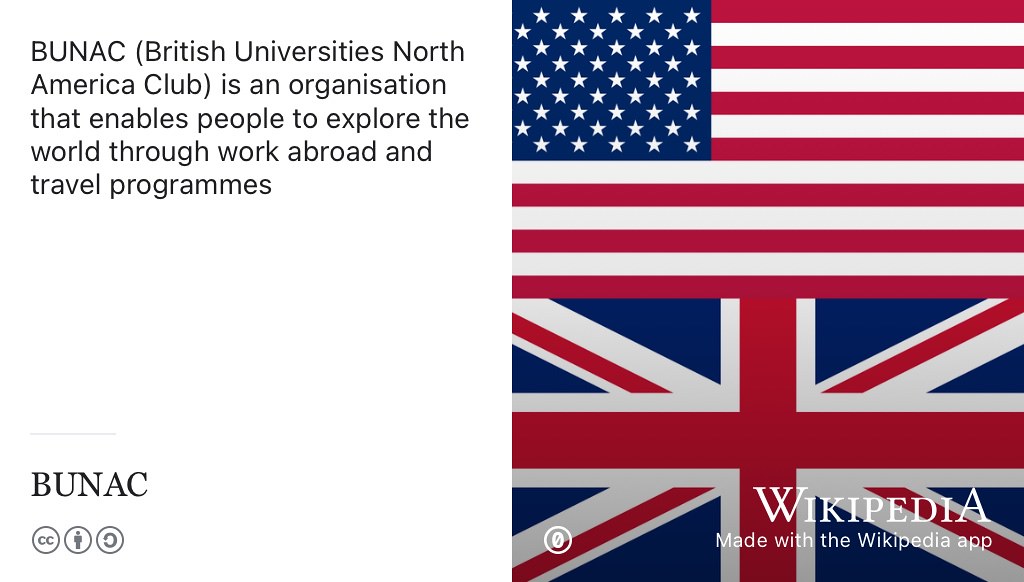
Figure 50.16: The British Universities North America Club (BUNAC.org) provides opportunities for students to work around the world. Public domain images of the Flag of the United States and the Flag of the United Kingdom via Wikimedia Commons w.wiki/4cRF and w.wiki/_wS2m adapted using the Wikipedia app
Thanks to Mitch at Green Tortoise Adventure Travel for driving, entertaining and feeding a bus load of us gentle people with flowers in our hair from San Francisco to New York via Chicago and some of America’s finest wildernesses (and cookouts) in Nevada, Utah, Wyoming, South Dakota, the Yellowstone, Grand Teton and Badlands National Parks. (Phillips and McKenzie 1967)
Thanks to Tom and Letty Gochberg for your excellent hospitality in New York City, your transatlantic history lessons and showing me the very best that Manhattan has to offer. You can hear it in my accent when I talk, I’m an Englishman in New York. (Sumner 1988) Thanks Pat, Colin and Rob Willmott for the introduction via the Single-handed Trans-Atlantic Race (STAR) in Plymouth, Devon from where the Mayflower (eventually) set off for the so-called “New World” in 1620, see figure 50.17.
Figure 50.17: Speedwell: No New Worlds was an installation in Plymouth that invited the public to reflect on the legacy of the Mayflower’s journey, colonialism and the ecological state of our planet during the Mayflower 400 commemorations in 2020. The words remind us that while America may have been a “new world” to Europeans it had already been occupied by indigenous people for thousands of years. (Hampton, Hopes, and Hampton 2020) You can also watch the 6 minute video embedded in this figure at vimeo.com/470916178 (Hopes, Hampton, and Hampton 2020)
Thanks Timo Hannay for letting me gatecrash the best party in Silicon Valley: Science Foo Camp (#scifoo) at the Googleplex in Mountain View, California in 2007 and again in 2009. Thanks to Cat Allman, Sergey Brin, Chris Di Bona, Tim O’Reilly and Larry Page for hosting scifoo. (Hull 2007, 2009)
Thanks Boston, Massachusetts for the Pixies. I wanna grow, grow up to be, be a debaser. DEBASER! (Francis 1989) Thanks Boston hosting disruptive tea parties with the Sons of Liberty, the W3C Healthcare and Life Sciences Interest Group (HCLSIG) and the Association for the Advancement of Artificial Intelligence (AAAI) conference (Hull et al. 2006). Thanks Joanne Luciano for showing me the sights of Cambridge, Massachusetts. Thanks to Ewa Deelman, Yolanda Gil and Bertram Ludäscher for hosting transatlantic workflow collaborations at the San Diego Super-duper-computer Center (UCSD) & University of Southern California (USC) with help from Carole Goble and funding from the Engineering and Physical Sciences Research Council (EPSRC).
So thanks America, I love you guys! 🇺🇸 Thanks America for being American. 🙏
50.17 Thank you Moravians
Thanks to Thsespal Kundan, Principal of the Moravian Institute in Rajpur, Dehradun, Uttar Pradesh, India for hosting me and my friend Doug fresh out of high school on a gap year. We learned loads as visiting supply teachers of English and Mathematics, thanks to an introduction from a mutual contact Angus Barker, see figure 50.18. 🇮🇳

Figure 50.18: The Moravian Institute lies in the foothills of the Himalayas between Dehradun in the Doon Valley and the hill station of Mussoorie. Situated between the Yamuna and Ganges, the institute was founded in 1963 by the late Reverend Eliyah Thsetsan Phuntsog in Ladakh, Jammu & Kashmir state to provide education for Tibetan refugees fleeing from their homeland across the Himalayas.
Thanks also to the Moravians in Manchester at Fairfield High School for Girls (see section 50.10) for hosting undergraduate Computer Science students as part of coding their future.
So thanks Moravians (and Angus) for life changing and formative experiences. 🙏
50.18 Thank you influencers
Some of the most important influences on this guidebook are people I’ve only met very briefly, virtually or not at all (yet).
- Thanks to Gayle Laakman McDowell, for your cracking series of books (G. L. McDowell 2014, 2015; G. L. McDowell and Bavaro 2013; Bavaro and McDowell 2021) which have been very useful resources both for students I’ve worked with and me personally
- Thanks to Yihui Xie (@yihui) and contributors to bookdown.org, the software used to produce this book alongwith the comprehensive and well-written documentation on using it. (Xie 2017, 2015; Xie, Dervieux, and Riederer 2020)
- Thanks to Bronnie Ware for your book The Top Five Regrets of the Dying (Ware 2011) which helped me to re-align my values and priorities when they were all out of kilter
- Thanks to Jo Hobbs at Lancaster University for advice on placements and employability in undergraduate teaching
So, thanks influencers for being influential. 🙏
50.19 Thank you interwebs
Thanks to the artists, blaggers, bloggers, cartoonists, columnists, doodlers, diarists, essayists, film-makers, journalists, photographers, podcasters and writers whose words and pictures I’ve enjoyed reading, watching and listening to via the magic of the interwebs, see figure 50.19.

Figure 50.19: The pen is mightier than the sword, and so is the keyboard. Thank you mighty writers for your incisive words. Your writing provides an existence proof that everyone benefits from good communication. CC BY SA picture of a backlit keyboard adapted from an original by Colin on Wikimedia Commons w.wiki/4sQd
So here are some people whose stuff I read, watch, listen to or use, maybe you’ll enjoy their words, pictures and software too:
- Euan Adie at blog.overton.io/author/euan-adie
- Steven Appleby see figure 50.20
- Jonathan Black at ft.com/dear-jonathan
- Tim Bray at ongoing
- Geoffrey Challen at geoffreychallen.com/essays
- Jorge Cham at phdcomics.com
- Tom Crawford at TomRocksMaths
- Paul Downey at whatfettle.com and flickr.com/photos/psd
- Mike Croucher at walkingrandomly.com
- Stephen Curry at occamstypewriter.org/scurry
- Athene Donald at occamstypewriter.org/athenedonald
- Stephen Dubner at freakonomics.com
- Alf Eaton at hublog.hubmed.org
- Jonathan Eisen at phylogenomics.blogspot.com
- Michael Eisen at michaeleisen.org/blog
- Julia Evans at jvns.ca
- Martin Fenner at blog.front-matter.io
- Kevin Fong at bbc.in/35jDOwI
- Timothy Gowers at gowers.wordpress.com
- Matt Green at mattgreencomedy.com
- Mark Guzdial at computinged.wordpress.com
- Paul Graham at paulgraham.com
- Bosco Ho at boscoh.com
- Pierre Lindenbaum at github.com/lindenb
- Andrew Maynard at andrewmaynard.net
- Randall Munroe at xkcd.com
- Cameron Neylon at cameronneylon.net
- Peter Norvig at norvig.com
- Samuel Pepys at pepysdiary.com
- Neil Saunders because what he’s doing is rather desperate
- Sue Sentance at suesentance.net/blog
- Kristin Stephens-Martinez at csedpodcast.org
- Greg Tyrelle at nodalpoint.org
- Greg Wilson at third-bit.com
Figure 50.20: Artist Steven Appleby explains some simple techniques for drawing. Useful techniques that can also be applied to writing anything, playing music, living life etc. The 6 minute video embedded in this figure can also be viewed at youtu.be/G_Vz7gTh1VE (Appleby 2008)
So, thanks writers for writing. Thanks for penning, drawing and recording stuff that has provoked, informed, entertained, influenced and inspired me. 🙏
50.20 Thank you githubbers
Thanks to everyone who has contributed via github, listed below in order of github usernames. I will credit any github contributors here, small or large. Even the typos, it all counts. I don’t care what operating system you are using either, see figure 50.21. You can easily add yourself to this roll call (see section 0.8) by correcting my delibreate mitsakes. 😉
Aman (@amanrana1), Keith Mitchell (@apiadventures), Arpan Pandey (@Arpan-206), Zee Somji (@ezeethg), iliketohelp (@iliketohelp), Jan Machacek (@janm399), teobalmos (@teobalmos), Tsvetankov (@Tsvetankov), Richard Gourley (@richardgourley), Tristan Maat (@TLATER), Safder Iqbal (@safderiqbal), Merve Turan (@mervturan), Mehuli Basu (@mehuli12), Rui Xu (@Ray7788)
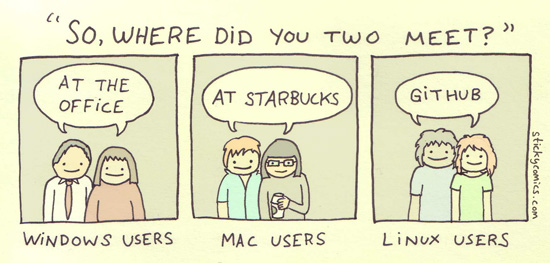
Figure 50.21: Windows users meet in the office, Mac users meet in Starbucks while Linux users meet on github. Comic by Christiann MacAuley at sticky comics stickycomics.com/where-did-you-meet used with permission see stickycomics.com/permissions. Thanks Christiann.
So, thanks githubbers for cloning, forking, merging, pulling, adding, committing, pushing and raising issues. 🙏
50.21 Thank you Wikipedians
Thanks to all the thousands of editors and engineers that make Wikipedia one of the greatest communities on the internet, see figure 50.22.
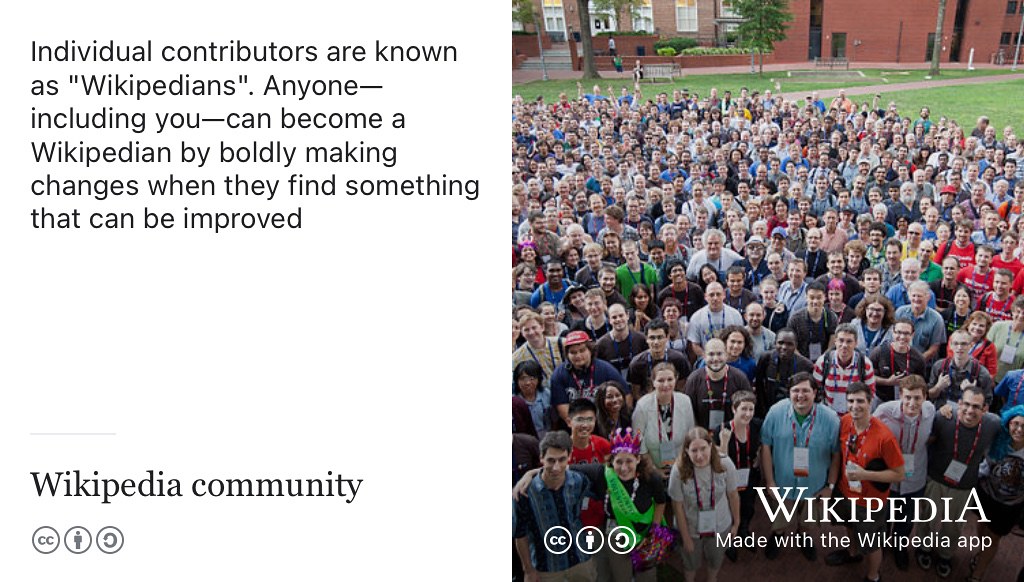
Figure 50.22: A small fraction of the Wikipedia community that works to give free access to the sum of all human knowledge to every single person on the planet. CC BY-SA picture of Wikipedians gathered at the annual Wikimania conference in 2012, adapted from an original by Helpameout on Wikimedia Commons w.wiki/3YLJ using the Wikipedia app. Like this image, many of the illustrations in this guidebook are re-used or adapted from openly licensed images taken from commons.wikimedia.org
Special wiki-thanks to English speaking Wikipedians Evan Amos, Abd Alsattar Ardati, Caroline Ball, Marianne Bamkin, Roger Bamford, Alex Bateman, Dan Brickley, John Byrne, Manu Cornet, Lucy Crompton-Reid, Daria Cybulska, Andrew Davidson, Paul Gardner, Madeleine Goodall, Aaron Halfaker, Melissa Highton, Eoin Houston, Dariusz Jemielniak, Chris Koerner, Darren Logan, Magnus Manske, Andy Mabbett, Charles Matthews, Ewan McAndrew, Daniel Mietchen, Josh Minor, Peter Murray-Rust, Richard Nevell, Frank Norman, Paul Nurse, Rod Page, Bhavesh Patel, Mike Peel, Martin Poulter, Joseph Reagle, Frank Schulenburg, Gage Skidmore, Dario Taraborelli, Sara Thomas, Denny Vrandečić, Ian Watt, Alice White, Jessica Wade, Taha Yasseri for insights, inspiration, support, software, data, pictures and guidance. Thanks also for educating me on issues of equality, diversity and inclusion, especially gender and race.
So, thanks Wikipedians for being Wikipedia. 🙏
50.22 Thank you Bryan
Many of the illustrations for this book have been drawn by the very talented Bryan Mathers shown in figure 50.23.
Bryan is an artist, visual thinker, entrepreneur and listener who turns stories into pictures. He also happens to have a Bachelors degree in Computer Science from the University of Glasgow. As a renaissance man, his combined skills in art, science and engineering made him the perfect fit for illustrating this guidebook. You can find out more about Bryan at bryanmathers.com and visualthinkery.com. I’m very glad we randomly bumped into each other at the #wikiedu20 conference: wikiedusummit.coventry.domains.
Figure 50.23: People tell stories and stories paint pictures. Bryan Mathers, who has illustrated much of this guidebook, telling stories at TEDxGalway in 2021. You can watch the full 15 minute video embedded in this figure at youtu.be/IapGM5ZYBEw (Mathers 2021)
So, thanks Bryan for your witty illustrations, this book wouldn’t be the same without your visual thinkery. 🙏
50.23 Thank you St Laurence
Thanks to St Laurence comprehensive school (st-laurence.com), a community I am proud, lucky, privileged and grateful to have grown up in and still be part of decades later: Adam, Alan, Andrea, Andrew, Anna, Bouncing Barney, Charlotte, Catherine, Clare, Dan, Doug, Debbie, James, Jenny, Jim, Jo, John, Jon, Lou, Marcus, Marjorie, Matthew, Philip, Portia, Richard, Sasha, Scott, Simon, Sophie, Sophia, Stephen, Steve & Wilf. I’m especially grateful for the friendship of former St Laurence school students I’ve enjoyed music, cycling, football, walking, travelling, holidaying, drinking and camaraderie with, see figure 50.24. So:
I’m looking forward to the next revolution of our ongoing adventures.
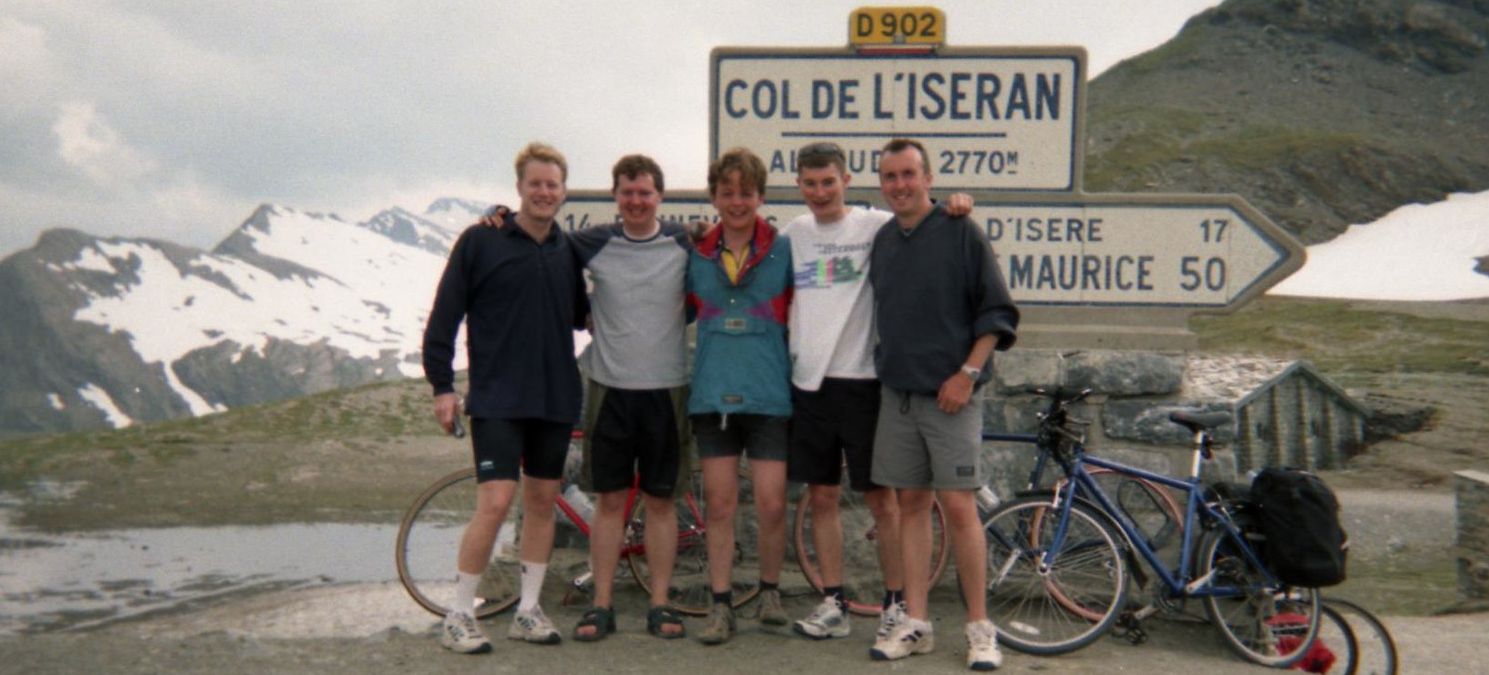
Figure 50.24: Crossing the highest paved mountain pass in Europe, the Col de l’Iseran in France, with my fellow alpinists and Kings of the Mountains: Jim, Dan, Doug and Dan. Allez, allez, allez! Unlike professional riders in Le Tour we had heavy panniers and no performance enhancing drugs besides vin de table and l’hospitalité française. Rest in Peace Dan, you were a cherished friend, we all loved you and miss you terribly. Camarades et amitié, Tour de France, Tour de France. 🇫🇷 (Bartos, Hütter, and Schneider 1983)
Special thanks to former St Laurence school student Aidan Blowers for showing me around The Clarendon School in Trowbridge, Wiltshire and leading by example. Aidan’s performance as Lord of the Dance (wearing a white shirt in figure 50.25), inspired the ongoing musical experiment that is Tuning Complete.
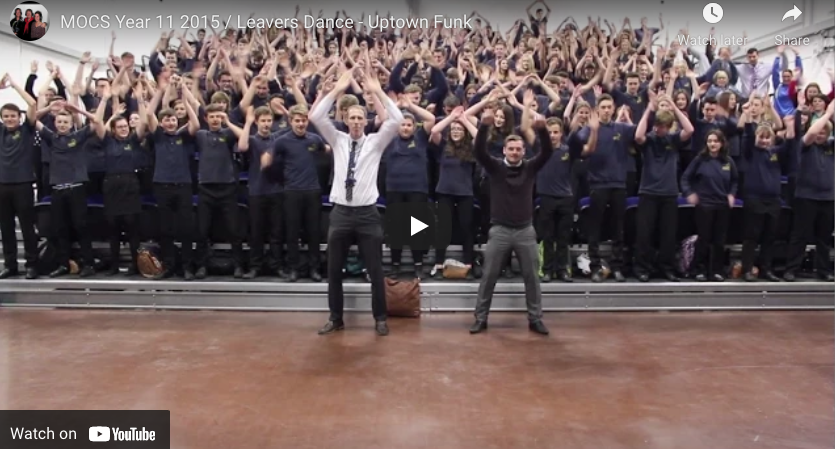
Figure 50.25: Year 11 leavers of Melksham Oak Community School (MOCS) in Wiltshire dance to Uptown Funk with help from Mark Ronson, Bruno Mars and Aidan Blowers. The image in the figure is a screenshot. Don’t believe me, just watch, come on! youtu.be/z8qH05teRMM (Ronson and Mars 2014; Blowers 2015)
Thanks to all my teachers at St Laurence school, some of whom can be seen in figure 50.26.

Figure 50.26: The staff of Fitzmaurice Grammar School shortly before it merged with Trinity secondary modern school to form the comprehensive St Laurence school in 1980. Back row, left to right, Alistair Thomson, Tony Hull, Geoff Swift, Peter Knight, John Warburton, John Blowers, Stuart Ferguson, Tim Wilbur, Bob Hawkes, Harry Haddon, John Blake. Centre row: Joan Davis, Lynne Powell, Doug Anderson, Colin Steele, Virginia Evans, Joan Van Ryssen, Margaret Osbourne, Mireille (French Assistante), Sally Burden, Margaret Gadd. Front row: Ken Revill, Marilyn Maundrell, Noreen Brady, Sid Johnson, Gerald Reid (Headmaster), Meg Tottle-Smith, Enid Wicheard, Diane Satterthwaite, Liz Buchanan, Margaret Hore. Picture via Keith Berry. (Berry 1998)
Thanks to the rest of my St Laurence school teachers not pictured in figure 50.26. In alphabetical order: Phil Arthur, Sally Arthur, Maggie Bignell, Jackie Bolton, Tony Brooks, Dave Brush, Mrs. Buthlay, Andrew Butterworth, Cathy Cooper, Ed Corrin, Mrs Davies, Brian Ellis, Myra Ettridge, Sue Glanville, Ms. Gledhill, Roger Greenwood, Barry Hales, Amanda Hodges, Steven Hollas, Maddy James, Mr Jones, Madame Lindsay, Karen Long, Sheila Macdonald, Simon Mitchell, Lee Musselwhite, Tim Noble, Roger Norgrove, Dave Pegg, Angela Pendennis, Sally Rose, Brian Reynolds, Steve Stretch, Mr Sadler, Mike Sullivan, Phil Smith, Rob Townhill, Beryl Tucker, Chris Watters, James Wetz and Bill Wheeler.34
Thanks to all of the school governors for holding the leaders of St. Laurence to account. I’m a #StateSchoolProud member of the 93percent.club. (Hull 2024)











Figure 50.27: The badge of St. Laurence School. The emblem is an adaptation of the Fitzmaurice badge with a pair of gudgeon fish symbolising the union of the two schools St. Laurence was created from: Trinity secondary modern school and Fitzmaurice Grammar School. 🐟🐟
So, thank you to the community that is St. Laurence School, for enabling my GCSE’s followed by A-levels in Physics, Chemistry, Biology and General Studies. Thanks for educating me (and many others) the West Country way. Proper job! 🙏 (Stoke and Green 2013)
50.24 Thank you Fitzmaurice
Thanks to my Fitzmaurice Primary School school teachers: Mrs Cripps, Miss Clarry, Morris Clay, Neil Fleming, Mr Jackson, Betty Knowles, Mr. Lucas, Valerie Payne, Miss Sheldon, Hugh Solomon, Miss Uncles and Mrs White. I used to foolishly think it was secondary schools that did all the serious teaching, but they’d be nowhere without the crucial foundations laid in primary school. It takes a whole community (a village) to raise a child and a lot of that starts in primary school, see figure 50.28.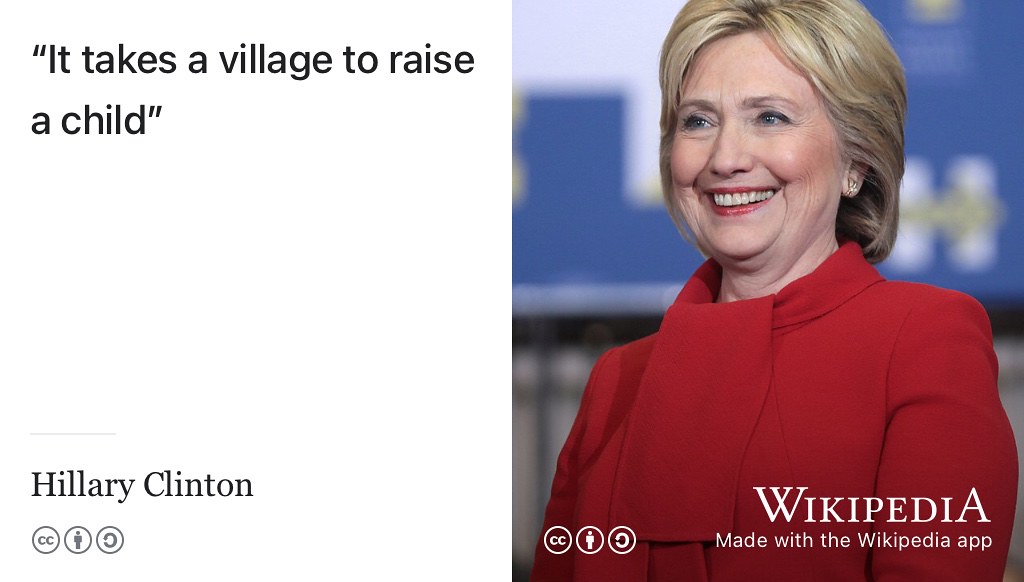
Figure 50.28: It takes a village to raise a child. (Clinton 1996) Bradford-on-Avon in Wiltshire is my village. Portrait of Hillary Clinton speaking in 2016 by Gage Skidmore on Wikimedia Commons w.wiki/4Xrc adapted using the Wikipedia app
So thanks Fitzmaurice Primary School and Edmond Fitzmaurice for laying solid foundations. 🙏
50.25 Thank you Branwen
Thanks Branwen Munn, pictured on the far left in figure 50.29, for introducing me to writing loops on the BBC Micro at Fitzmaurice Primary School with help from Mr. Jackson’s code club, see section 37.14. We were lucky to also have access to your very own Commodore 64. Like Emma Mulqueeny I think year 8 is too late. (Mulqueeny 2011) It is unlikely I would have ended up where I am if it hadn’t been for early exposure to computing in primary school. (Danton 2021)
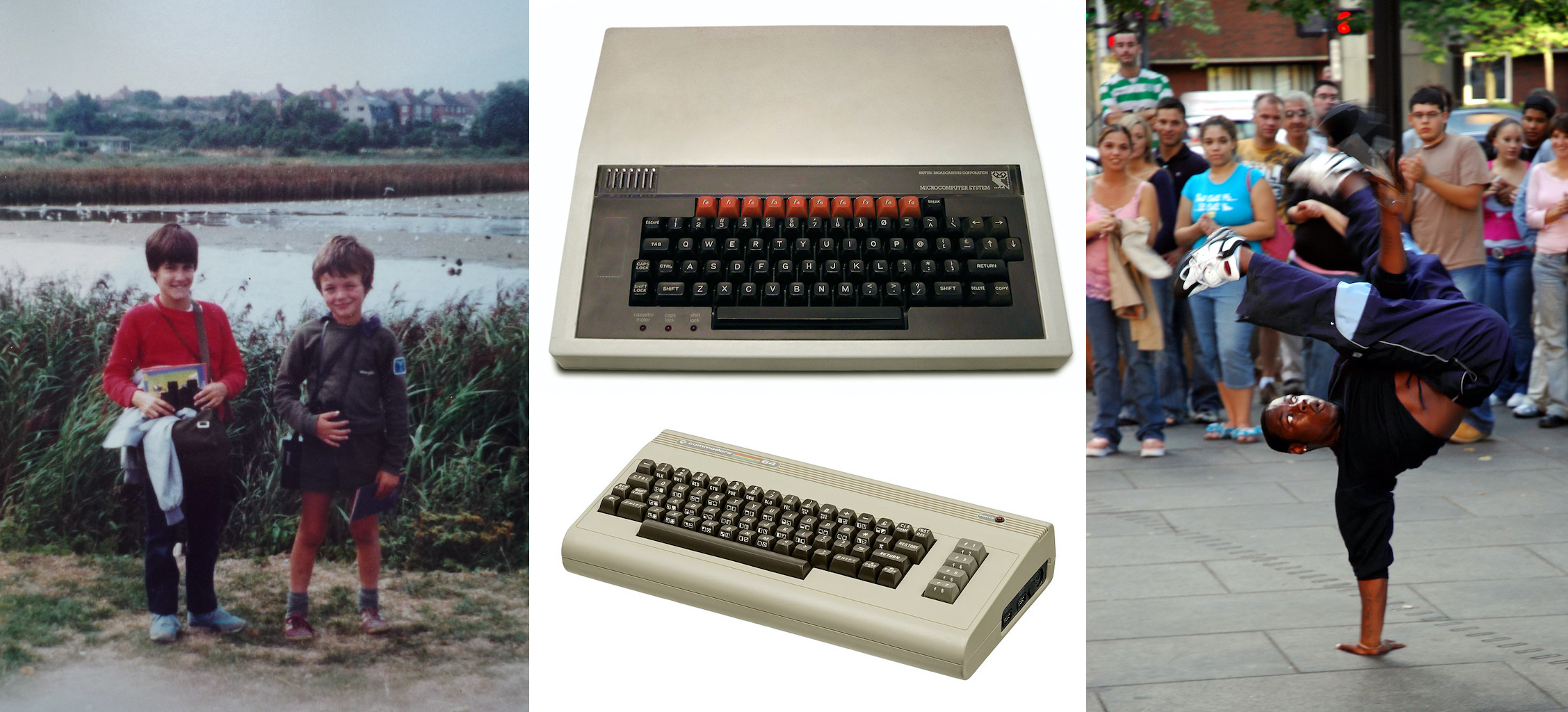
Figure 50.29: From left to right: LEFT: Birdwatching at Radipole Lake in Weymouth, Dorset with Branwen (left) and me (right), members of the Young Ornithologists’ Club (YOC). MIDDLE: (Top) A BBC Micro (model A) from our after school code club with 16KB of memory. Public domain picture by Stuart Brady on Wikimedia Commons w.wiki/6cfw (Bottom) Branwen’s Commodore 64 with whopping 64KB (yes, kilobytes) of memory, it was four times more powerful than the schools BBC Micro, public domain picture by Evan Amos on Wikimedia Commons w.wiki/6ait. RIGHT: When we weren’t birdwatching or computing we were breakdancing. CC BY portrait of a breakdancer via Wikimedia Commons w.wiki/6cfx. Yes we are geeky and yes, we’ll always wear our geek badges with pride! Blessed are the geeks, see section 1.6.
So thanks Branwen, for all the breakdancing, birdwatching, music and computing.
50.26 Thank you NHS
Thank you NHS for all the healthcare you’ve provided for me and my family from our cradles to our graves, see figure 50.30. I had taken your services for granted until I thought I was on my deathbed, see section 2.2.7. Thankfully, I was granted some extra “Fergie time” from the Grim Reaper. (Pritchard 2012) ☠️

Figure 50.30: Thank you NHS started in during the COVID-19 pandemic when people in the UK posted messages of gratitude for their National Health Service (NHS), to acknowledge their crucial work. Picture adapted from an original CC-BY-SA picture of the NHS logo painted on road outside North Walsham Hospital in Norfolk, England by Whippetsgalore on Wikimedia Commons w.wiki/55Wc
So, thanks NHS ❤️ for all the publicly funded healthcare. 🙏
50.27 Thank you family
To my family: wife, son, mum, dad, brother, sister, μαμά, μπαμπά and extended family: I’m lucky to have been taught by you and that you’ve always been there when I needed you. 🇬🇷🇪🇺🇬🇧

Figure 50.31: The Acropolis of Athens is home to the Parthenon, a temple dedicated to Αθήνα: the goddess of wisdom and warfare. Picture of the Acropolis at night from the Pnyx with Hymettus in the background by George E. Koronaios adapted from an original on Wikimedia Commons w.wiki/4c2t.
So, thanks to all my family scattered around the world for your unconditional love.
Για πάντα σ’αγαπώ. 🙏